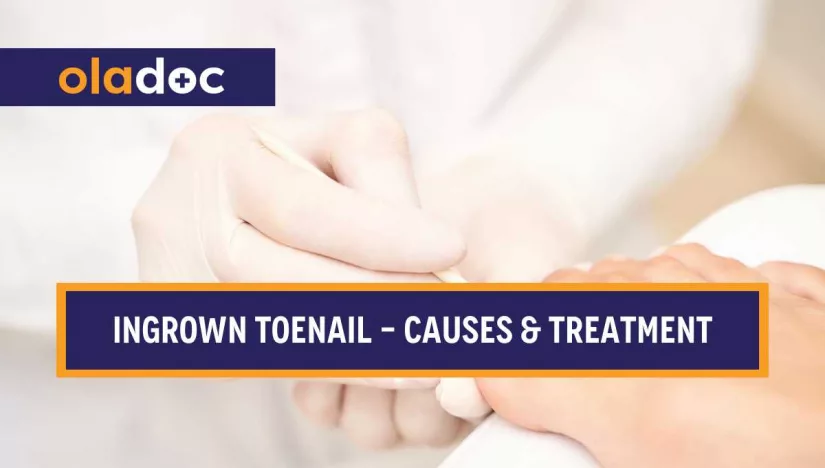Ingrown toenails occur when one or both sides of a nail grow into the skin resulting in significant pain and swelling. If left untreated, they can lead to infections and other health complications.
Since ingrown toenails can increase the risk of infection, people must remain vigilant regarding their physical health. They must contact a dermatologist if they experience pain or discomfort.
The specialist will conduct a physical examination to evaluate the severity of the condition. Proper treatment helps the individual recover smoothly without further complications.
Table of Contents
What Is An Ingrown Toenail?
The inward growth of toenails is called onychocryptosis. The symptoms of onychocryptosis include:
- The individual suffers from pain near the toenails. It affects movements and causes extreme discomfort.
- The patient can notice redness around the toenail.
- The patient suffers from swelling around the toenails.
- The individual may limp due to pain and discomfort while walking.
- Skin tenderness can affect the movement and functioning of the individual.
- The individual is at a higher risk of suffering from an infection, which can delay recovery and cause further complications.
What Causes Ingrown Toenails?
The common causes of ingrown toenails are:
- Wearing tight shoes
- Improper nail trimming. Cutting the nail too short or round around the edges
- The genetic predisposition increases the chances of suffering from ingrown toenails. Middle-aged men are at a higher risk of ingrown nails.
- Trauma or injury to the nail plate or the toe can lead to ingrown toenails.
Ingrown Toenail Complications
People suffering from infections due to ingrown toenails must take proper treatment to avoid complications. Without timely treatment, it can lead to:
- The patient is at a higher risk of suffering from bone infection, which can affect the functioning of the vital organs and body movement.
- The patients are at high risk of suffering from gangrene. Diabetic patients should be more vigilant and monitor body changes to avoid complications.
How To Prevent Ingrown Toenails
The preventive measures that help reduce the risk of ingrown toenails are:
- Do not cut your nails too short
- When cutting toenails, trim straight instead of rounding the edges of the nail
- Do not wear tight shoes
- Diabetic patients must monitor the changes in the skin, hair, and nails for early diagnosis.
Diagnosis
The specialist will conduct a physical examination. The exam will help notice swelling and redness around the toenails. Additionally, the indications of pus correlate with infections.
The specialist will ask the patient about prior medical conditions that can slow the recovery. Aldo, diabetic patients must be more vigilant, as it can cause permanent damage.
Ingrown Toenail Treatment
The effective medications and procedures to treat ingrown toenails are:
- Use of Analgesics: The medications help provide instant relief from pain and discomfort. The analgesics help them manage the pain and move around.
- Use of Topical Antibiotics: Patients with toenail infection use topical antibiotics. The medication helps fight the infection and relieve the pain.
- Matrixectomy: People who suffer from recurrent toenail infection may have to undergo the procedure. Chemical and excision destroy the sides of the toenails to prevent pain and complications.
- Wedge Resection: The procedure helps remove the affected art from the nail plate. Diabetic patients have to undergo the procedure to avoid infection and related complications.
Home Remedies For Ingrown Toenail
Following are some effective home remedies for ingrown toenails:
- Soak your feet in warm water with Epsom salts 3 times a day for 10-20 minutes
- Wear comfortable shoes
- Keep the affected area clean and dry
- Apply a topical antibiotic ointment to prevent infections
- Use OTC pain relievers to reduce your pain and discomfort
- Wear a toe protector
These remedies can help with reducing swelling, redness and pain however proper treatment of an ingrown toenail is necessary. Individuals with ingrown toenails can consult a skin specialist for guidance regarding a treatment plan.
The dermatologist will help the patient opt for a suitable procedure and aftercare steps to avoid complications. In some cases surgery may be required to remove the entire toenail or part of it. This procedure is usually carried out under local anesthesia.
Frequently Asked Questions
1. How to get rid of ingrown toenail
Soaking your feet in warm water with Epsom salts can help manage pain and swelling at home, while antibiotics and pain relievers can reduce your pain. Consult a skin specialist or podiatrist for the proper treatment of ingrown toenails.
2. Will an ingrown toenail eventually grow out?
In some cases, an ingrown toenail can heal on its own and eventually grow out. However, most Ingrown toenails usually do not go away on their own; hence, they should not be left untreated.
